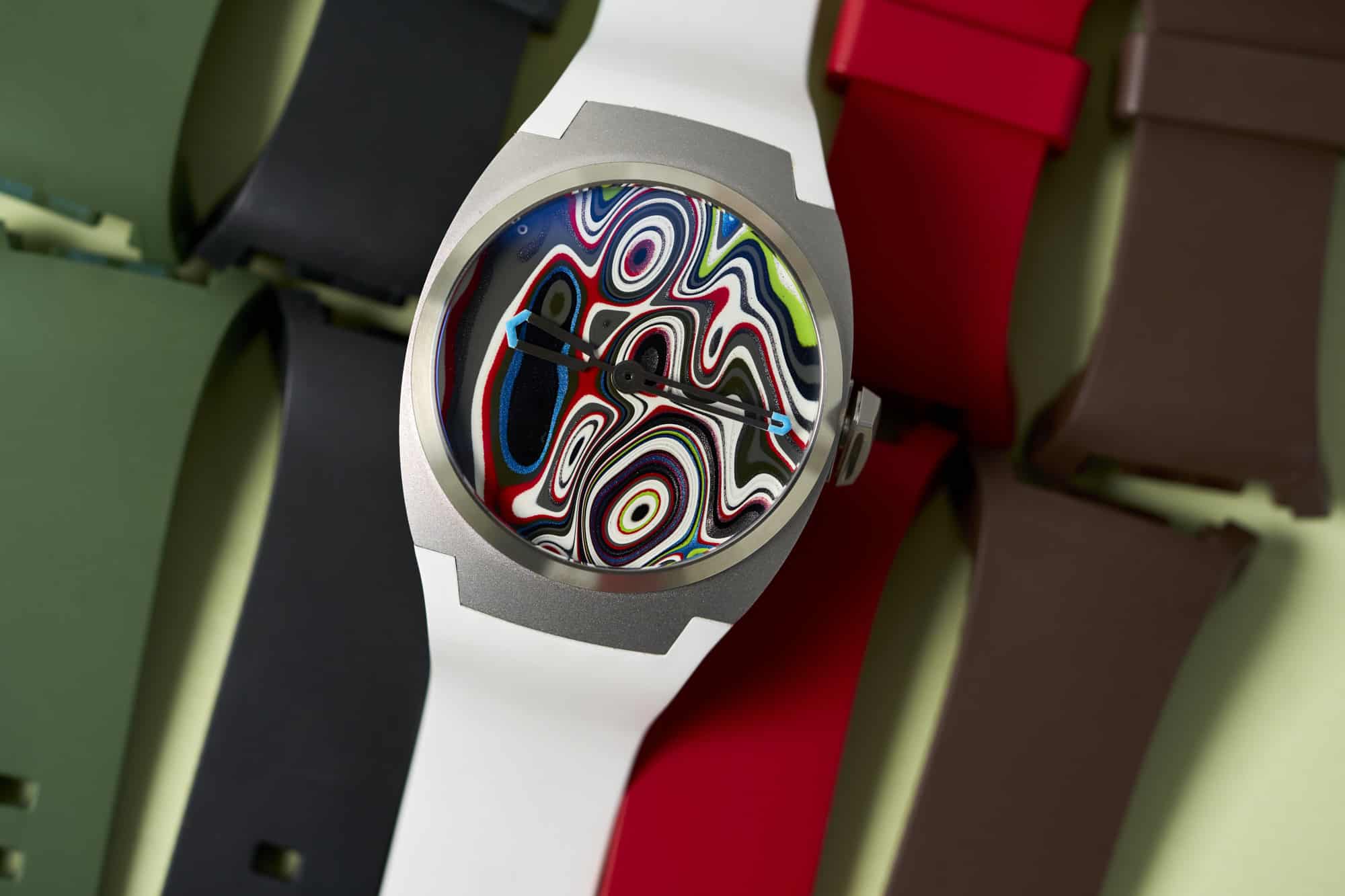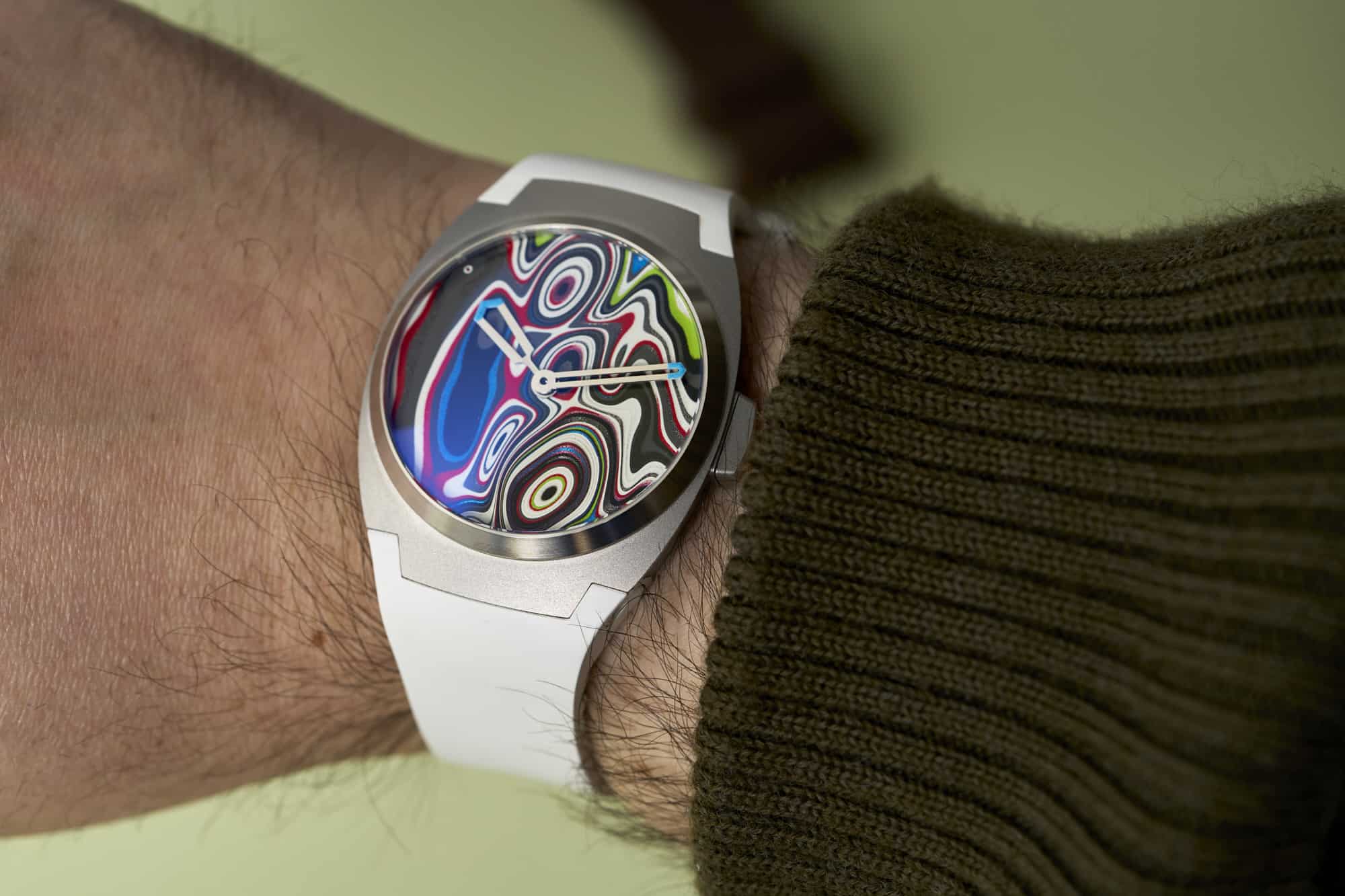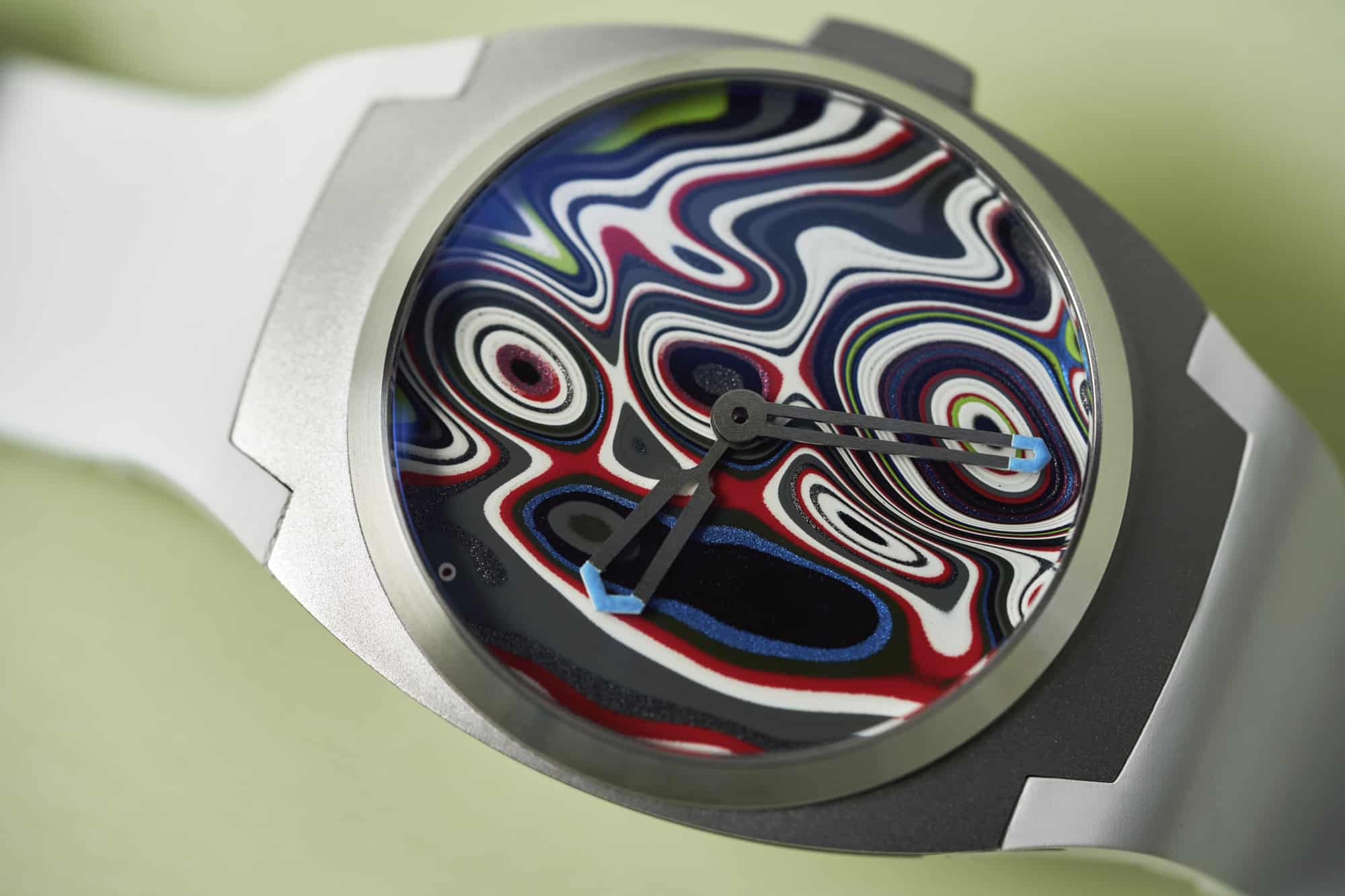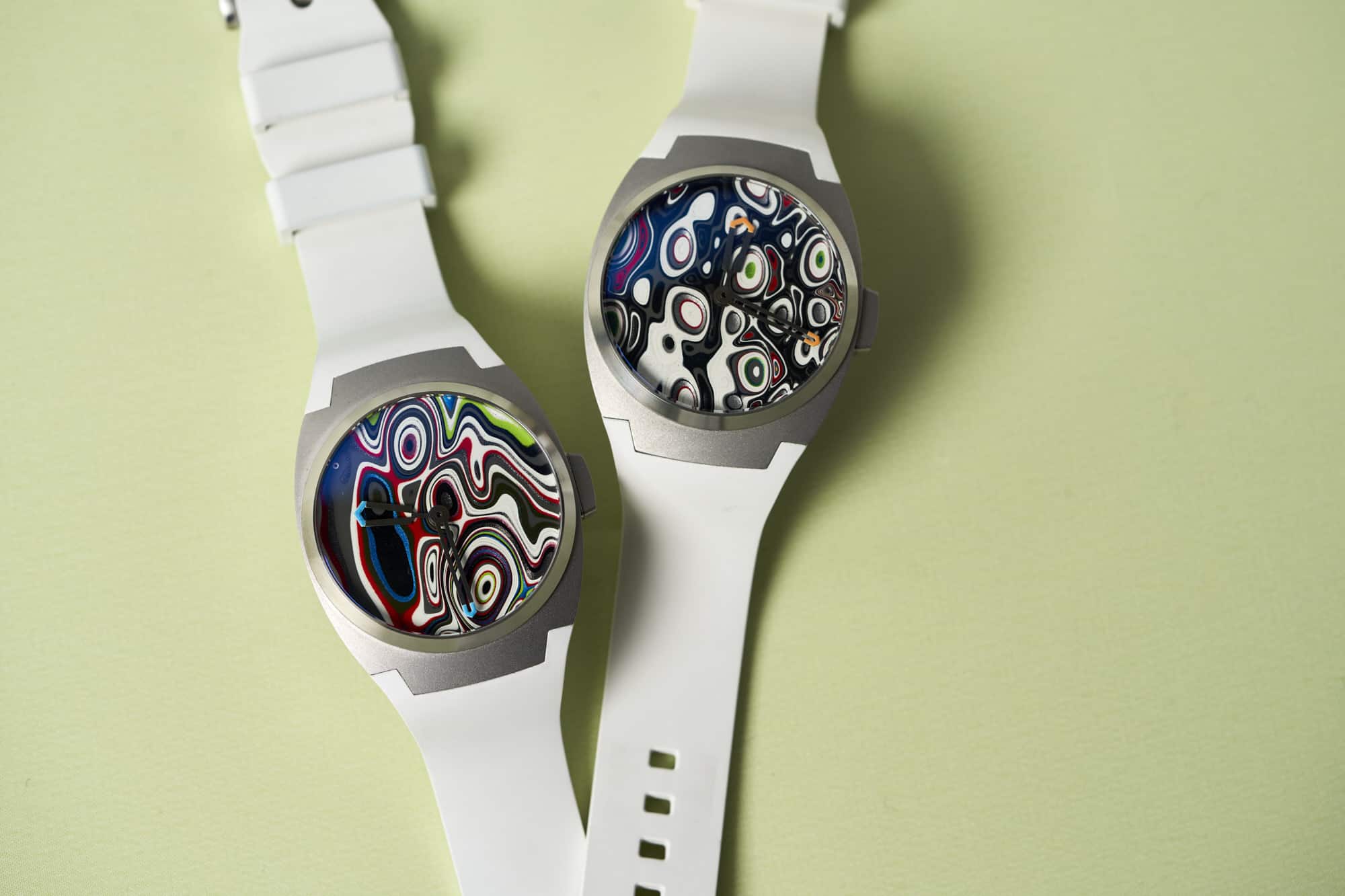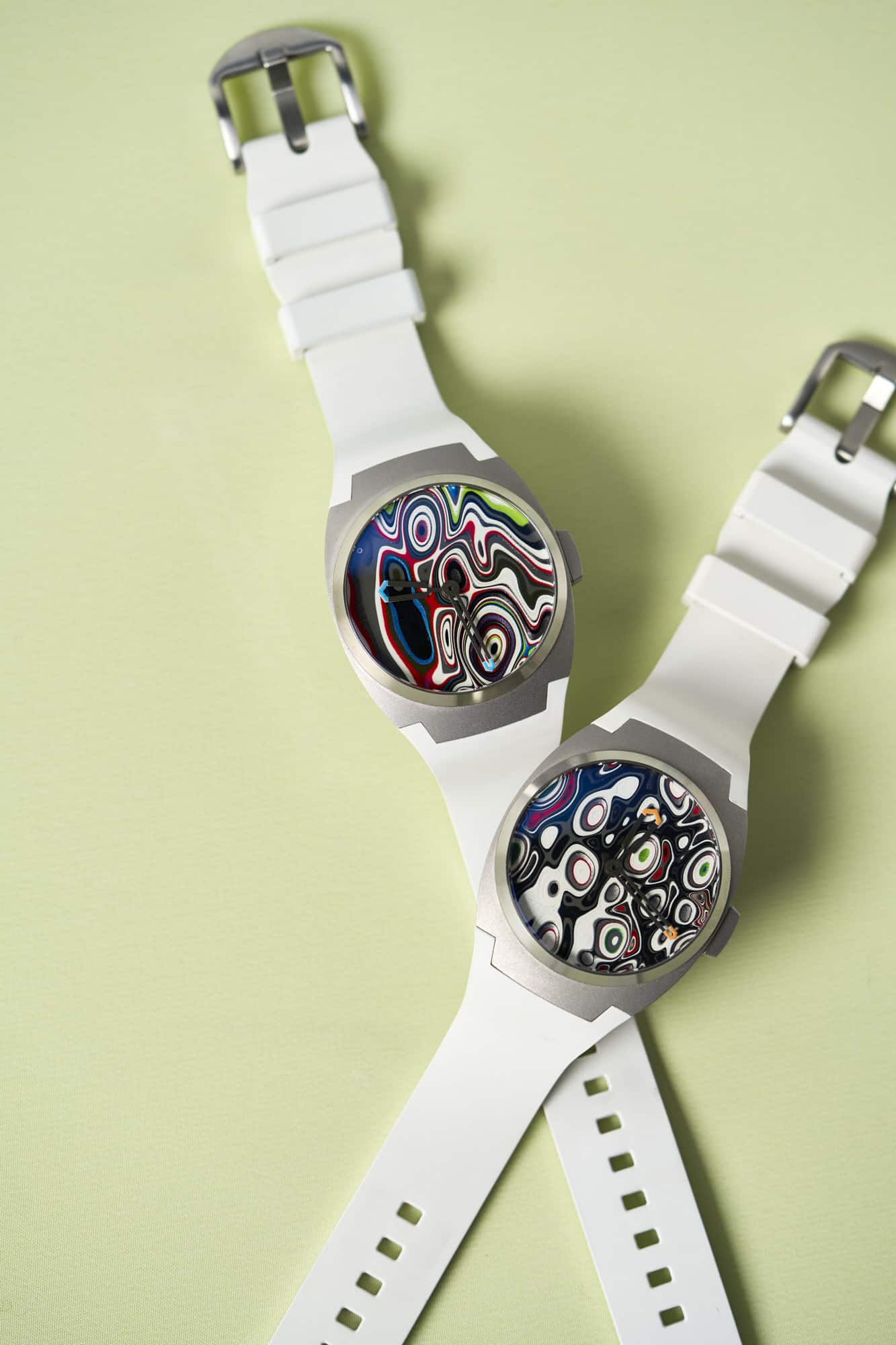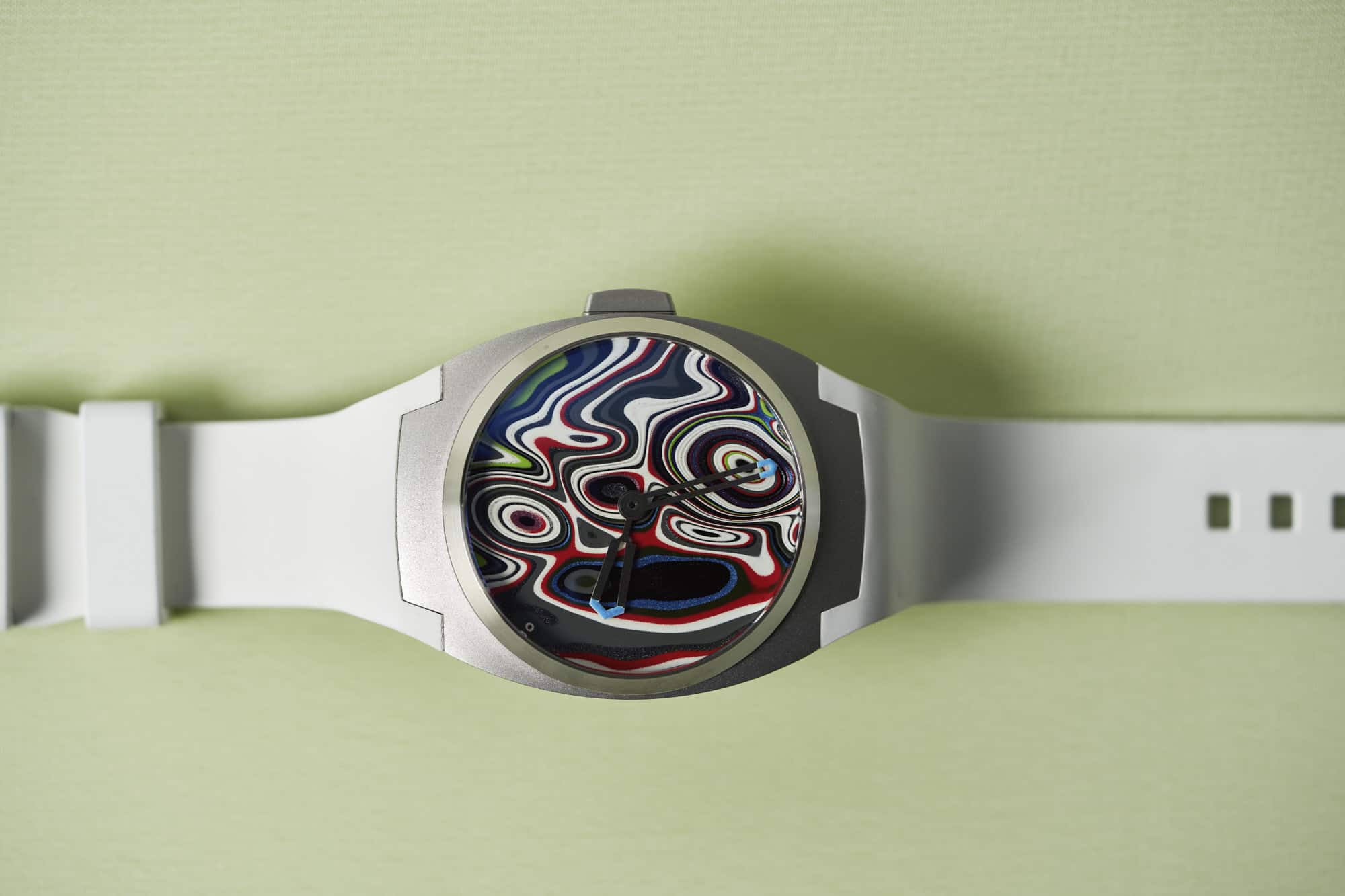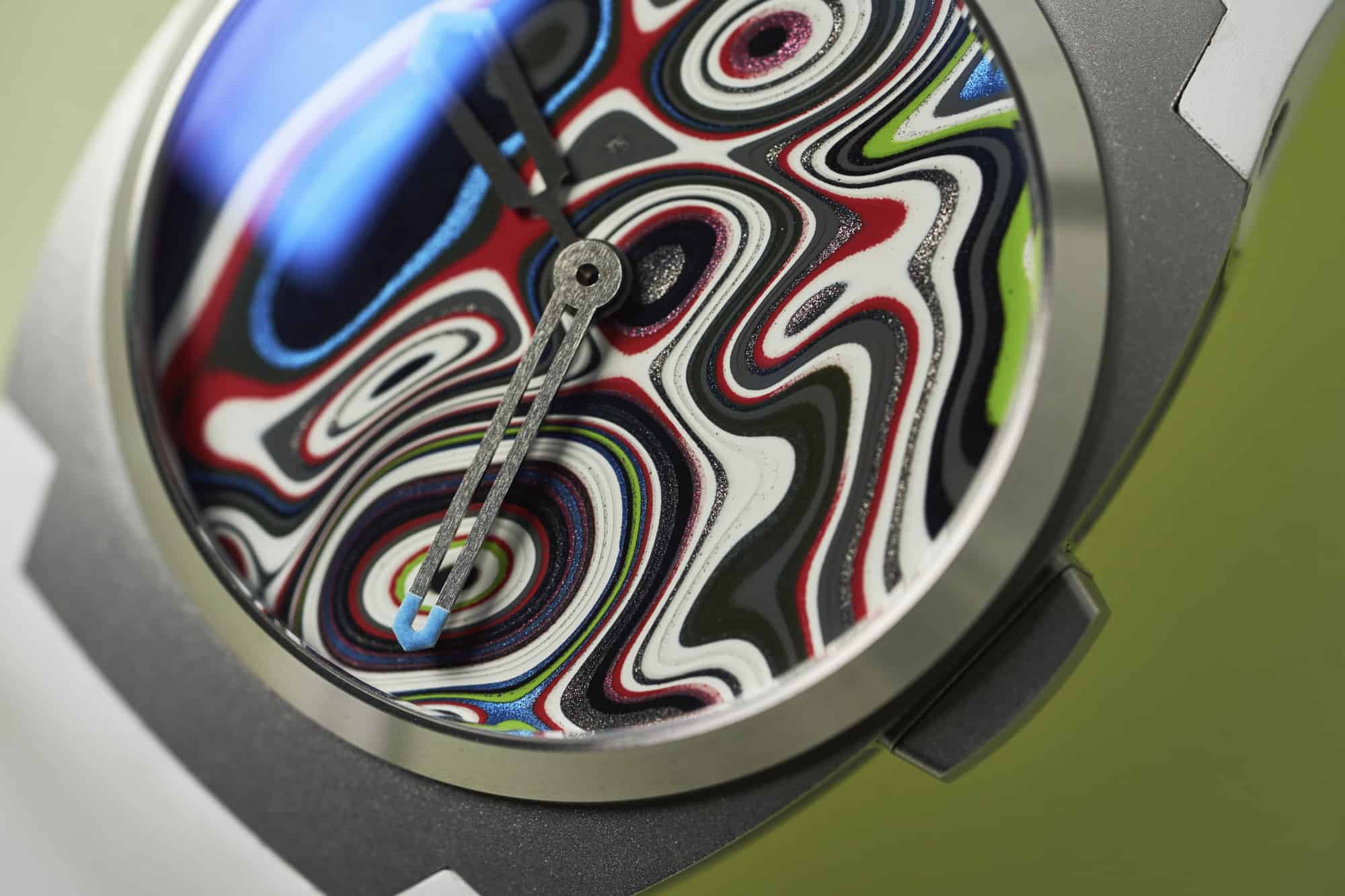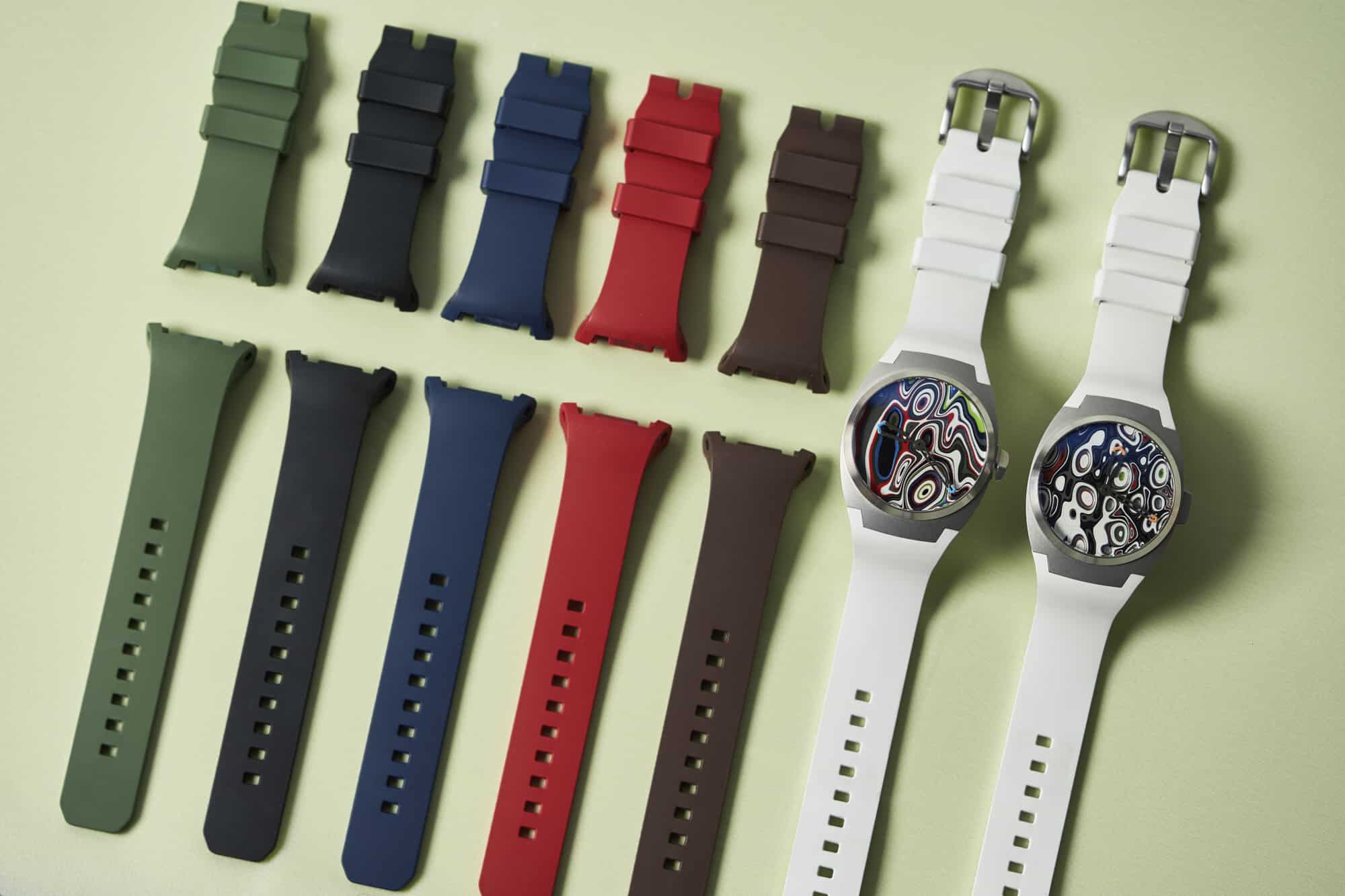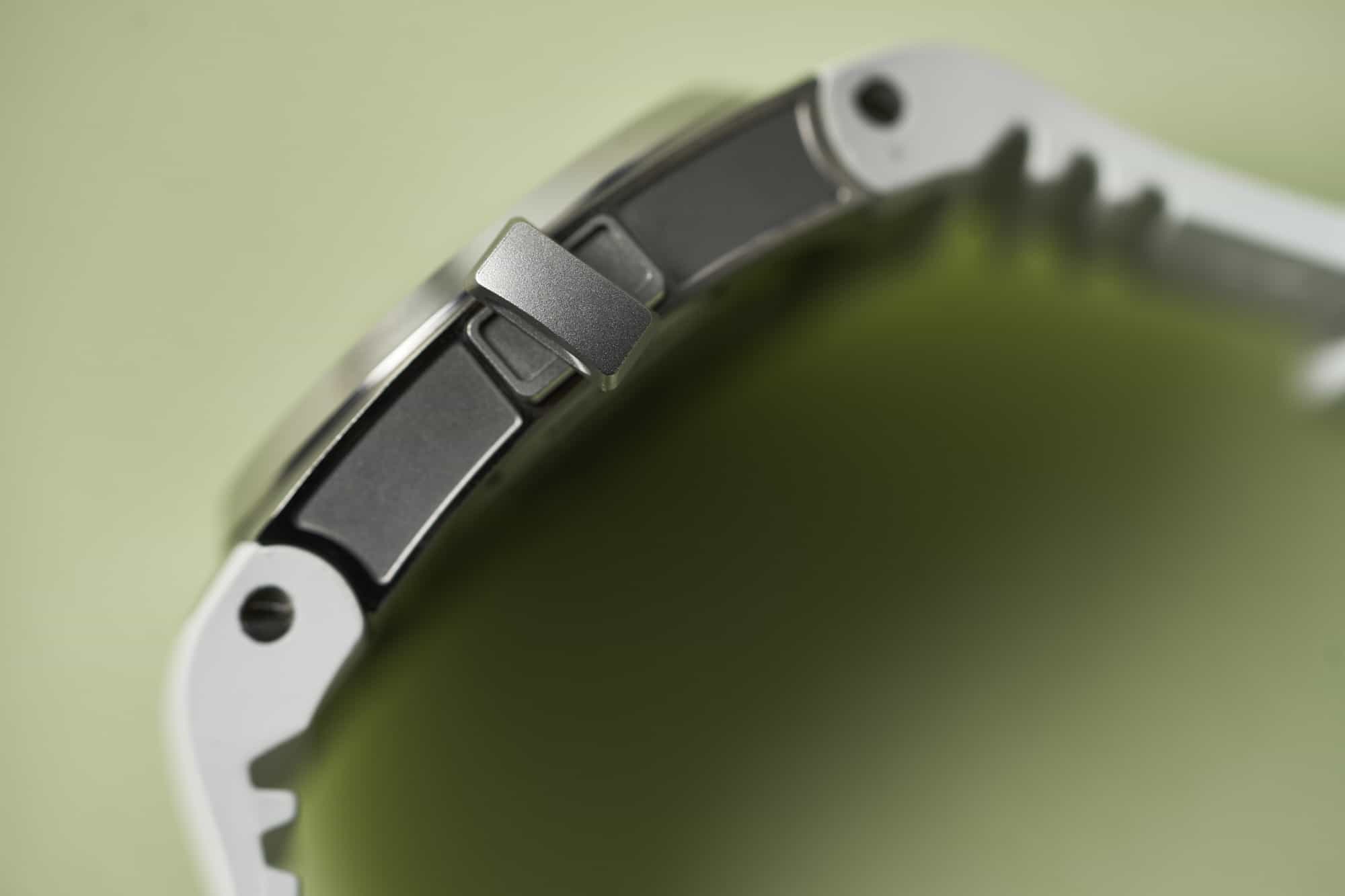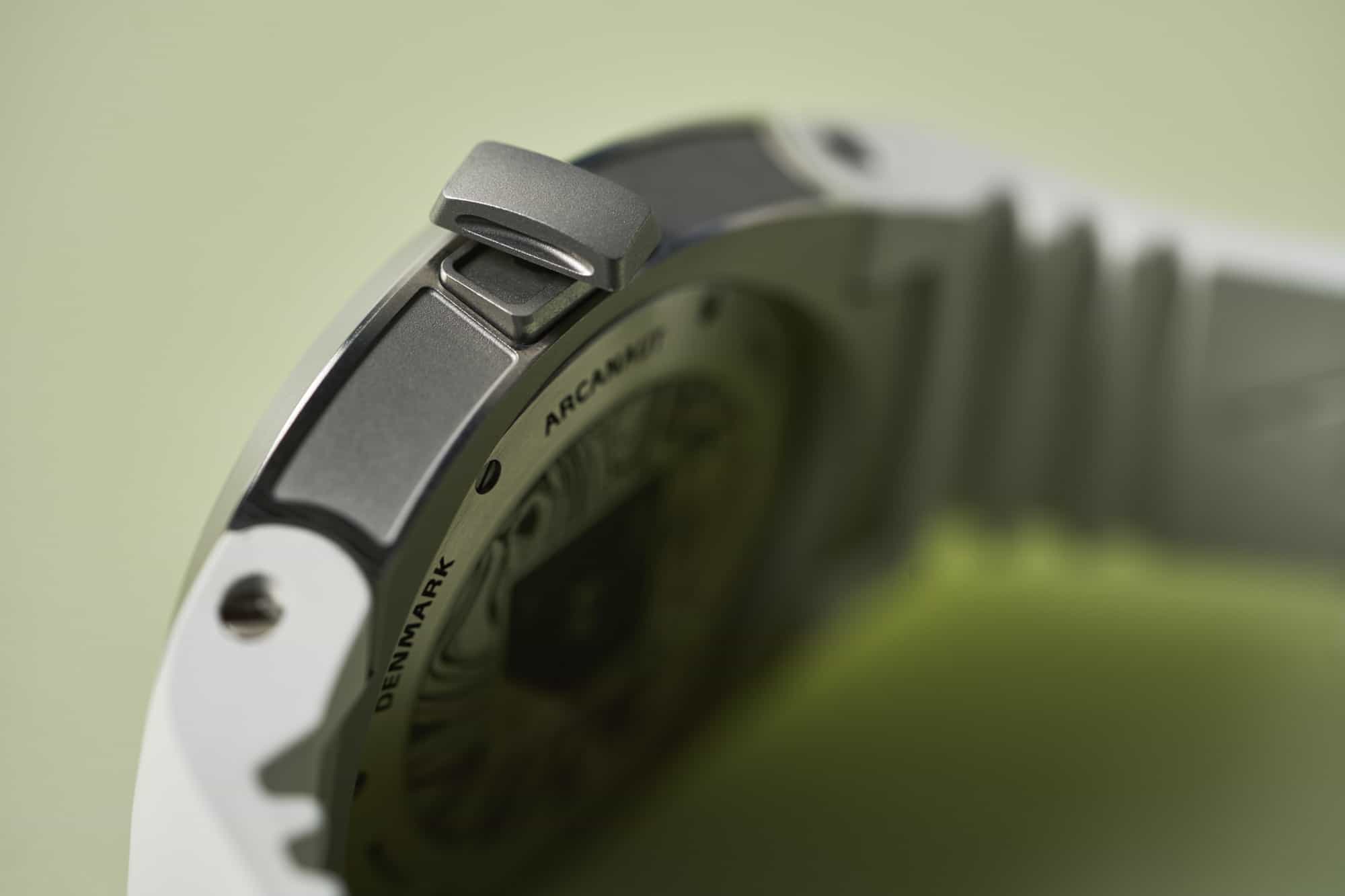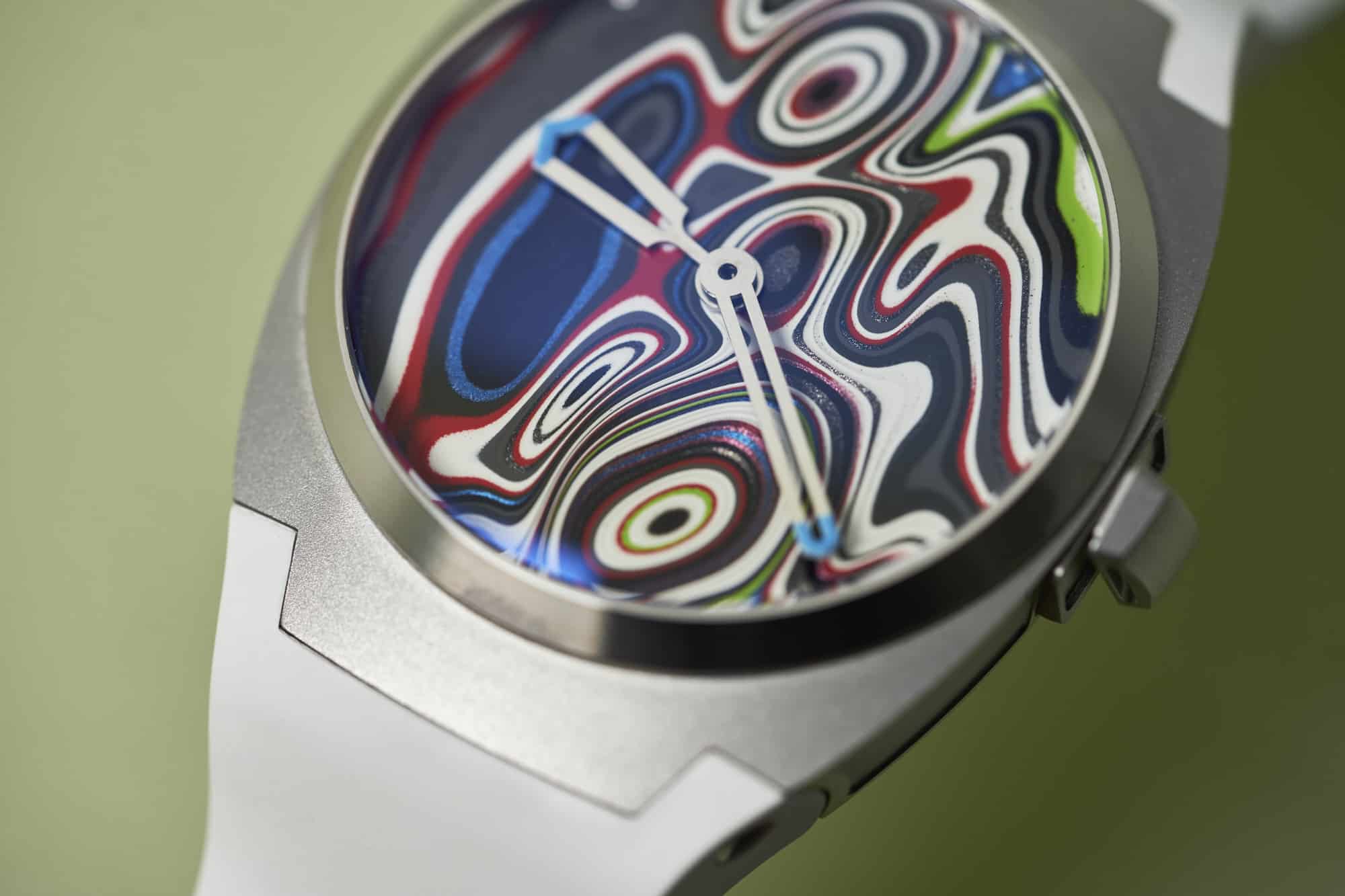It’s a simple fact that the longer we’re involved in this hobby, the more difficult it is to get really excited about any particular new watch. It doesn’t mean we love the hobby, or watches, any less, but it’s a natural side effect of constantly being exposed to new stuff. I wouldn’t say I’ve become blasé or jaded about new watches as a whole, but let’s just say that over time, I’ve found it easier and easier to reach a point of objectivity when evaluating something. I was already perhaps a little less inclined to be emotionally attached to a watch, and with several release cycles under my belt as a “professional” in the industry and being fortunate enough to handle some of the coolest watches that have been made over the last several years, it’s easier, not harder, to see them for what they are, and to look beyond whatever marketing, Instagram, or collector hype is associated with it.
Owner’s Review: The Arcanaut Arc II Fordite
So, for me, it’s notable when I take a step back from a new watch and realize I’m getting excited about something the way that I used to, when I was new to the hobby and felt like every new watch I handled (or just read about) was a great new discovery. As I’ve seen others enter the hobby since I’ve gotten involved, I’m frequently jealous of that feeling – I think it’s something all of us, regardless of our experience level – are chasing. Why wouldn’t we? If it’s a healthy intellectual curiosity about the history and stories behind these objects that drives us, that feeling of discovery is what ties everything together.
The problem, of course, is that you can only discover something once. So while the watch remains, and will, in fact, last forever, that moment is fleeting. We can remember it, obviously, and look upon it fondly, but if you’re involved in watches at an enthusiast level, is that ever really enough? I think, judging by the constant stream of New Watch Alerts posted in my Instagram feed and the group chats I’m in, and the levels of obsession with new releases I see in the same places, the answer is clearly “no.” So we’re always on the lookout for something new, exciting, and genuinely different.
For many of us, the search for something that lights that fire inside leads to independent brands. That’s certainly core to what this website is all about. Micro brands, we should stipulate, are every bit as independent as your MB&Fs and Journes, if considerably more limited in what they can accomplish based on simple economics. What links the independence of a capital “I” Indie with a micro is a sense of creativity, and a willingness to try something outside the box. It doesn’t take a ton of money or R&D to have a great idea, but it sometimes does to properly execute that idea. The “micro indies” that I’ve come to have a real fondness for find a way to capitalize on those great ideas and the raw talent of those behind the brands to give their customers something truly special without creeping into an insane price point.
Owner’s Review: The Arcanaut Arc II Fordite
And that brings me to Arcanaut, the brand behind the Arc II Fordite, which for me is the most genuinely exciting new acquisition I’ve made in quite some time. Normally I’d be hesitant about writing an Owner’s Review of a watch I’ve had in the rotation for only a few months (I picked mine up in April), but every time I put the watch on, I think of something else I want to say about it. More than that, I just want this watch and this brand to be on people’s radar, because what they’re doing is special, and the emotional response I’ve had to this watch in the form of dopamine spikes is like little else I can think of for under $4,000. Honestly, part of it is because this watch is under $4,000.
I think we have to begin with paint. Specifically, paint used in the production of American cars between roughly the 1940s and the early 1990s. In that period, new cars were painted with spray paint by hand. An imperfect process, the enamel paint would naturally run off the vehicles and collect underneath in the tracks and skids that the cars were painted on. Over time, layer upon layer of paint in every color imaginable would accumulate in these bays, and harden in ovens when the cars were sent to cure on these same tracks. At a certain point, the accumulated paint would need to be removed from the tracks, and with that you wind up with large blocks of multicolored paint that, when viewed in a cross section, resemble naturally forming agate and other rock formations. The name for this material, “Fordite,” is obviously a play on words incorporating the name of the best known American automaker, but the painting process was largely the same at other automakers in the US during this time. Industrious and creative artisans realized this material can be sanded, polished, and cut to size for the purposes of making jewelry, and that’s where we get the unique fordite dials found in these Arcanaut watches.
When I say “unique,” of course, I mean it literally. No two fordite dials will be exactly the same, and in fact can vary wildly in their characteristics. They’re also unique in that they’re a small snapshot in time. Cars are no longer painted by hand – the big plants use an electrostatic process that “sticks” the paint to the car body without any waste or runoff. In other words, they aren’t making any more of this stuff. It’s hard to say how much fordite is out there, and it’s even more difficult to say how much of a premium should be paid for a material that is literally waste but technically, perhaps, in short supply. It’s easy to imagine that the vast majority of fordite was simply discarded.
The use of fordite in these watch dials is the brainchild of James Thompson, otherwise known to the watch community as Black Badger. Thompson is a designer by trade, and now the co-owner of Arcanaut, but he’s been hanging around the watch industry for quite some time. He’s still perhaps best known in the community for being absolutely obsessed with insanely bright lume, and has worked with Linde Werdelin, MB&F, Sarpaneva, and others over the years to infuse their watches with a psychedelic dose of impossibly bright glowing material that seems to defy the laws of physics. Those brands that he’s involved with should also give you a sense of his taste: Thompson has an eye for the slightly off-kilter, and perhaps more than slightly ridiculous.
These days, while I don’t think Thompson has abandoned creating lume filled objects completely, he’s banging the drum hard for fordite. When I met him at the Windup Watch Fair in San Francisco a few months ago, he was walking around with a few small bricks of the stuff, ready to show it off and extol its virtues as a material. And it is a very cool material. In its roughest shape, it doesn’t look like much, but through Thompson’s process of sanding and polishing the small pieces that make up the dials of the Arc II, he’s able to create something that looks and feels high end. It doesn’t exactly provide the impression of a precious stone, but it’s close, and satisfying in its own way. Part of it, honestly, is having an understanding of where the fordite came from. Or, more precisely, having a vague idea of where it came from, but not knowing exactly. Part of me thinks it would be cool if Arcanaut was able to provide a little more information on the factories each individual dial came from, and a specific year (on their website, they indicate they’re using Fordite from Detroit area Ford plants dating between the 1970s and 1990s). But I also like not knowing, and being able to make up that story in my head.
The “when” of it all, is important. Not just because they stopped spray painting cars by the 90s, but consider the colors of the cars that were rolling off the assembly lines of the American carmakers during that time. I recall lots of white, dull maroons, beige everywhere, and blues and blacks. Not exactly the most vibrant and exotic rainbow of color. Cars of an earlier era, much like watches, were more adventurous in their color options, and that’s reflected in a big way in many of these fordite dials. Thompson has a good eye for picking out cross sections that are representative of an era and also allow for a certain coherence as a watch dial. Many dials, including my own, also include evidence of metallic paint, a hallmark of cars made throughout the 60s and 70s, via just a hint of reflective sparkle when the light hits just right. It’s a small detail, but aids greatly in tying these watches to a historical record.
In preparing to write this review, I’ve found that considering the specifics of my own Fordite dial is kind of a strange exercise. Typically in a watch review, I’d comment on the overall character of the dial, the color (usually there’s just one!), texture, dial furniture, and so forth. The abstract and random nature of a fordite dial makes analysis a challenge. My watch has darker paint on the 9:00 side, with loops of white accenting the middle section and 3:00 side. To my eye, it seems fairly balanced, but I know that’s subjective. My favorite thing about it is the way the blues and reds play together. It’s also instructive to look at the dial under magnification, as you can more clearly see the actual layers of paint, and gain a better understanding of how they built up over time.
One of the most frequent comments I get from people on the Arc II, whether they’re watch people or not, is along the lines of “Wow, it must be hard to tell the time on that thing.” The dial, wisely, has no indices or markings of any kind. Just the psychedelic swirl of paint, created at random, decades ago. The hands are skeletonized and lume tipped, and on my watch, they’re easy to spot on the dial in short order. (To be completely fair, sometimes this isn’t the case in other fordite dials I’ve seen, and it’s greatly dependent on the color pattern of each individual dial, and also, I suspect, your own vision).
I can say in all honesty that after a ridiculously short time with the watch (less than a day) I was completely comfortable telling the time at a quick glance. I’ve come to think over these last few months of ownership that stated difficulties in reading the time without indices are coming from people who have simply never made an attempt to do so. The bottom line, I think, is that if you know how to tell the time on an analog clock, you’re going to get the hang of this remarkably fast. I like to play a game with myself where I look at the Arc II dial and try to guess the exact time, to the minute, before checking it on my phone. Reader, let me tell you, I’ve become very good at this game. I challenge all comers. If they ever decide to make time telling an Olympic sport, I might finally have my shot at a medal. And to think, I owe it all to a guy who calls himself Black Badger.
Precision is certainly not the object of a dial like this. It’s an art piece, meant to be enjoyed primarily as an aesthetic object, and on those terms, in my own opinion, it’s a huge success. Naturally this is totally subjective. At least one founder of Worn & Wound has told me – to my FACE! – that this watch is unappealing. I think it might have been put somewhat less delicately than that, in fact. But that’s really part of the fun of a watch like this. It’s a little bit challenging, and maybe somewhat divisive, but it’s a conversation generator about what matters to us most in a watch ownership experience.
For me, that increasingly boils down to pursuing watches that are unique, and that feel as if they’re a result of a creative streak that resonates with me. I’m less and less inclined to be interested in watches that are cookie-cutter retreads of well worn themes. As well as they might be executed and as high quality as some of these watches indisputably are, I’m in a place where I’m just not excited about watches that are merely an expression of something we’ve seen many times before. I still have watches like that in my collection that I enjoy wearing, but I feel myself being pulled in more and more by the avant-garde and strange. Watches that bear the mark of creator’s vision, as opposed to a series of decisions made across a big conference table. There’s so much creativity and talent in the watch community – people with insanely great ideas who are willing to try seemingly anything – so the idea of another black dialed diver passing through my hands is just not hitting as hard as it used to.
Rarity and scarcity obviously don’t determine quality or an aesthetic impact, and have in some circles become ideas that are leaned against as excuses for buying things that otherwise might not hold much appeal. But what can I say? I’ve been involved in watches long enough now the itch of satisfaction when hunting for the next piece is tougher to scratch. Again, seeing more watches creates a dynamic where large volumes of watches become less compelling to own over time. The Arc II Fordite is a shot of adrenaline, and fills a space in my collection that, if I were a lottery winner or hedge fund guy, might be occupied by a very low production independent with a six figure price tag.
The dial here is obviously the literal centerpiece and the thing that most people will naturally want to discuss and fuss over. But the case (and strap) go a long way toward making this a watch that I keep wanting to pick up day after day. My first impression of the watch, before even putting it on my wrist, was that this thing is just going to be too big. It’s 41mm in diameter, but measures close to 50mm lug to lug (it’s hard to get an exact measurement because of the way the strap is integrated to the case – more on that soon). The key measurement, though, is the case height, which is 13mm, and that’s with a fairly dramatically domed sapphire crystal. The result is that we have a case that wears well across a large swath of wrist real estate, taking advantage of a gently curved midsection that hits the wrist in an almost cuff-like way. You could probably be fooled into thinking this measured around 10.5 or 11mm tall, as there’s a compact nature to the case that is both visually pleasing and ergonomically necessary.
Another factor that aids in overall comfort and wearability is the excellent rubber strap, which is quite soft and integrated in such a way that it angles sharply down around the wrist without extending laterally, a major pet peeve of mine. Once you dial in the fit and the watch is sitting in a spot that’s comfortable for you, it feels great, particularly for a watch over 40mm wide.
Like the dial, the shape of the case is going to be a love it or hate it affair. I suppose it’s vaguely tonneau shaped, but it’s honestly hard to find an apples to apples comparison. The finishing is serviceable, but not out of this world. The case flanks have a bead blasted finish with raised polished accents around the edges for contrast, which is my favorite touch. It has a kind of futuristic, almost sci-fi look to it, which is really apparent in Arcanaut’s other watches that don’t make use of a more whimsical fordite dial. Above all though, it’s just really comfortable, and happens to fit me like a glove.
You’ll notice that the crown is rectangular, designed to nestle perfectly within the confines of the case flank’s bead blasted section. This accounts for the single biggest quirk of the Arc II, which is the unusual solution the brand has come up with to ensure a perfect fit. Basically, the crown has two open positions. Pulling it out to its first position (via a tiny sliver on its underside that you can just about get a fingernail in) allows you to spin the crown freely on its stem. Nothing “functional” happens here, but it’ll be important in a minute, after you’ve set the time. That happens in the next position after giving the crown a second pull. The movement (a Soprod A10 automatic) is now hacked, and you’re free to set the time. A pro tip, if you want to be on the Olympic time telling team with me someday: set the time at a quarter hour interval if you can. The geometry is easier, and you’re likely to be exactly on target even without the aid of a minute marker.
OK, you’ve set the time. The crown is now likely to be in a position that does not line up with the case. Push it back to that first position (starting the movement), and now you can freely spin it so that the crown is perfectly aligned and ready to be set flush once again. You might have noticed that during this process, you never hand wound the watch, which is something many of us are accustomed to doing with our automatic movements to get them running after a period of inaction. Be prepared to feel all kinds of nostalgia for those Seiko SKX days, because this one will need a gentle shake to get going. While this isn’t a massive inconvenience or anything, I hope that in a future version of the watch there will be a hand winding capability. For now, it’s an acceptable trade off that allows for Arcanaut to adopt an interesting case and crown design. The free spinning crown solution is actually an elegant way to solve the inherent problem of its rectangular shape.
We’ve had an ongoing conversation on the website in recent weeks and months about the idea of a Fourth Watch, and also our “weird” watches that hold an appeal almost in spite of themselves. On the one hand, this watch fits nicely into those categories. It’s very obviously not a normal, or traditional watch in any sense. But I bristle a little bit at the idea of framing it as inessential. To me, a watch that challenges you, expands your palate, generates interesting conversations, and is made with care and attention by real people who put their whole lives into their work is the most essential kind of watch there is. The hobby quite literally needs watches like this to keep enthusiasts and collectors engaged.
I’m about three months into ownership of the Arcanaut Arc II and I’m still just as excited by it as I was on the day I bought it. Perhaps it’s a long honeymoon period, but it’s more likely that this watch just does an incredible job of tapping into something that has always appealed to me about high end independents, but doesn’t have anything to do with the actual “high end” piece of it. If the thing that draws you to crazy avant-garde watches is brazen creativity and a cohesive artistic statement, this watch is a great example of how those things don’t come at the same high cost as a movement made from scratch, or a case that’s been finished entirely by hand, or the use of five precisely shaped crystals that no other watch in production will ever need. As much as anything else, the Arc II Fordite is a triumph of making something special at an exceedingly fair price, and proof that a low production, genuinely unique watch that feels and looks every bit like a true indy is more accessible than you might think. Arcanaut









 Featured Videos
Featured Videos




